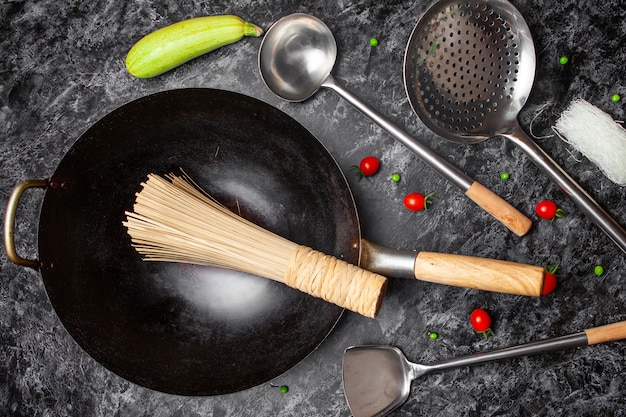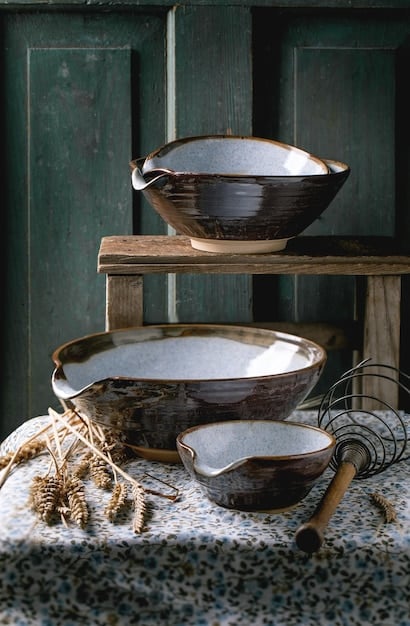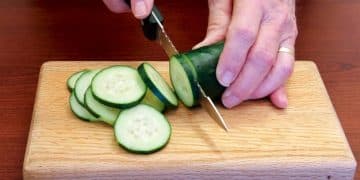Japanese Kitchenware Shopping: US Guide to Must-Have Tools

For US cooks seeking to elevate their culinary experience, navigating the world of Japanese kitchenware shopping involves identifying essential tools like versatile knives, efficient cooking vessels, and specialized gadgets that offer unparalleled precision and durability for diverse cooking needs.
For many US cooks, the allure of Japanese cuisine extends beyond its exquisite flavors to the precision and artistry of its preparation. This guide to Japanese Kitchenware Shopping: A US Cook’s Guide to Must-Have Tools and Gadgets will explore how these expertly crafted items can transform your American kitchen into a haven of culinary efficiency and enjoyment. Discover the essential pieces that blend tradition with modern needs, making every meal a masterpiece.
Understanding the Philosophy Behind Japanese Kitchenware
Japanese kitchenware is not merely about functionality; it’s an embodiment of centuries of craftsmanship, a deep respect for materials, and a philosophy that cooking is an art form. This approach emphasizes precision, durability, and beauty, translating into tools that are not only effective but also a joy to use. For cooks in the US, understanding this underlying philosophy is the first step in appreciating the value and intention behind each piece, moving beyond simple utility to a more holistic culinary experience.
The concept of “kaizen,” or continuous improvement, is deeply ingrained in the creation of Japanese kitchen tools. This means that even the simplest items, like a grater or a pair of chopsticks, have often undergone meticulous refinement over generations to achieve optimal performance and ergonomic design. This attention to detail results in tools that feel like an extension of the cook’s hand, fostering a deeper connection with the ingredients and the cooking process itself.
The Art of Craftsmanship
Many Japanese kitchen tools are still made by skilled artisans, using techniques passed down through families. This artisanal approach ensures that each piece meets incredibly high standards, often incorporating traditional methods alongside modern advancements. From the forging of a Damascus steel knife to the glazing of a ceramic bowl, the human touch is evident, lending each item a unique character.
- Hand-forged Knives: Renowned for their sharpness, balance, and edge retention.
- Earthenware (Donabe): Traditional clay pots known for even heat distribution and tender cooking.
- Bamboo Utensils: Lightweight, durable, and gentle on cookware.
- Porcelain and Ceramics: Beautiful and functional pieces often reflecting regional artistic styles.
This commitment to artistry often means a higher initial investment, but the longevity and superior performance of these tools often justify the cost. They are built to last a lifetime, becoming cherished heirlooms rather than disposable items.
Functionality Meets Minimalism
While Japanese kitchenware can be incredibly specialized, there’s also a strong emphasis on practical, multi-functional designs. Many tools are designed to perform their specific task exceptionally well, simplifying complex culinary techniques. The aesthetic often leans towards minimalism, with clean lines and natural materials, reflecting a beauty that is both elegant and unobtrusive, seamlessly blending into various kitchen aesthetics.
Ultimately, investing in Japanese kitchenware is an investment in your culinary journey. It’s about acquiring tools that not only perform their intended function but also inspire greater precision, creativity, and enjoyment in your cooking, offering a unique blend of traditional wisdom and modern practicality.
This philosophy encourages a more mindful approach to cooking, where each step, from preparation to presentation, is given due attention. For US cooks keen on exploring new culinary horizons or simply enhancing their daily cooking, embracing this perspective enriches the entire gastronomic experience, making Japanese kitchenware an invaluable asset.
Essential Japanese Knives for the US Cook
No discussion of Japanese kitchenware is complete without highlighting its legendary knives. Revered globally for their unparalleled sharpness, balance, and precision, Japanese knives are often considered the cornerstone of any serious cook’s arsenal. For a US cook looking to elevate their culinary skills, understanding the variety and specific uses of these exquisite blades is crucial. They are designed not just for cutting, but for enhancing the entire food preparation process, making slicing, dicing, and chopping a truly effortless and enjoyable task.
The craftsmanship involved in creating a Japanese knife often involves intricate layering of steel, precise sharpening techniques, and ergonomic handle designs. This meticulous process results in blades that hold an incredibly sharp edge for extended periods, reducing the need for frequent sharpening and ensuring clean cuts that preserve the integrity and flavor of ingredients.
Understanding Blade Types and Their Uses
While there are many specialized Japanese knives, a few are particularly versatile and beneficial for the American kitchen. Choosing the right knife depends on your primary cooking style and the types of ingredients you frequently prepare. Each knife is engineered with a specific purpose, optimizing efficiency and safety in the kitchen. Learning about these key types will help you select the most impactful additions to your collection.
- Gyuto (Chef’s Knife): The most versatile, similar to a Western chef’s knife but often thinner and lighter. Ideal for general-purpose tasks like chopping vegetables, slicing meat, and mincing herbs. Its curved edge allows for a rocking motion, making it highly adaptable for various cutting styles in the US kitchen.
- Santoku (Three Virtues Knife): “Santoku” translates to “three virtues” — referring to its proficiency with meat, fish, and vegetables. It’s shorter than a Gyuto with a flatter blade profile and a rounded “sheep’s foot” tip, making it excellent for chopping and dicing with a straight up-and-down motion. Its compact size is often preferred in smaller kitchen spaces or for more precise work.
- Petty (Utility Knife): A smaller version of the Gyuto or Santoku, perfect for intricate tasks where a larger knife would be cumbersome. Great for peeling, trimming, and delicate slicing of fruits and vegetables. It combines the precision of a paring knife with slightly more length for versatility.
- Nakiri (Vegetable Knife): Designed specifically for vegetables, featuring a flat, rectangular blade. The Nakiri is perfect for precise, straight cuts and can easily chop through tough root vegetables. Its shape also makes it efficient for scooping ingredients off the cutting board.
- Deba (Fish Filleting Knife): A heavy, thick-spined knife used for butchering fish, including cutting through bones. While specialized, a smaller Deba can be a valuable tool for anyone regularly preparing whole fish. Its robust build provides the necessary leverage and strength for breaking down fish with ease.
Investing in a high-quality Japanese knife set can profoundly change your cooking experience, making meal preparation more efficient and enjoyable. Proper care, including hand washing and regular sharpening with a whetstone, will ensure these knives last a lifetime.

Specialized Japanese Cookware for the Modern Kitchen
Beyond knives, Japanese cookware offers a unique array of pots, pans, and vessels designed for specific cooking techniques, each contributing to distinct flavors and textures. For the US cook, integrating these specialized tools can open up a world of culinary possibilities, allowing for the precise preparation of traditional Japanese dishes and an enhanced approach to global cuisine. From gentle steaming to robust simmering, Japanese cookware provides the optimal environment for ingredients to shine.
These pieces are often designed with efficiency and natural material properties in mind, ensuring even heat distribution, moisture retention, and durability. Their thoughtful design reflects the Japanese culinary philosophy of honoring ingredients and achieving harmonious flavors, making them much more than simple cooking vessels.
Exploring Unique Cooking Vessels
Japanese earthenware and metal cookware pieces are not just functional; they are often beautiful pieces of art that can go directly from stove to table, adding to the dining experience. Their unique properties make them indispensable for achieving authentic Japanese flavors and for imparting superior results to a variety of dishes. Understanding their specific benefits will help you choose the ideal additions to your kitchen.
- Donabe (Earthenware Pot): A traditional clay pot perfect for hot pots (nabe), stews, and even rice. Donabes cook evenly and gently, retaining heat exceptionally well. They are ideal for community dining, bringing people together around a single, bubbling pot, and impart a unique earthy flavor that enhances winter meals.
- Tamagoyaki Pan (Rectangular Frying Pan): Specifically designed for making rolled omelets (tamagoyaki). Its rectangular shape allows for thin layers of egg to be easily folded, creating the characteristic multi-layered Japanese omelet. This pan can also be used for other small, flat cooking tasks, but it truly excels at its intended purpose.
- Yukihira Nabe (Aluminum Pot): A lightweight, versatile aluminum pot with a dimpled surface that helps prevent boil-overs and makes it easy to clean. Ideal for simmering broths, boiling noodles, and blanching vegetables. Its hammered finish is not just decorative but also functional, improving heat distribution and preventing sticking.
- Otoshibuta (Drop Lid): A wooden lid that sits directly on top of food inside a pot, helping to distribute heat evenly and prevent ingredients from moving around or breaking. Essential for simmering dishes (nimono), ensuring flavors meld beautifully and ingredients remain submerged. It is a simple yet incredibly effective tool for controlled cooking.
- Grater (Oroshigane): While not a pot, a quality Japanese grater for ingredients like ginger, garlic, or daikon radish is essential. These graters are designed to create a fine, fluffy texture that releases maximum flavor, unlike many Western graters which can tear fibers. Crafted for efficiency, they make quick work of even tough root vegetables.
Incorporating these specialized items into your US kitchen allows for a deeper exploration of Japanese cuisine and enhances the outcome of everyday cooking. Their thoughtful design facilitates precise control over cooking conditions, resulting in superior flavors and textures that are difficult to achieve with conventional cookware. Proper care, such as seasoning donabes and cleaning them gently, will ensure longevity and performance.
Beyond Knives and Pots: Gadgets and Utensils
The Japanese kitchen is a treasure trove of ingenious gadgets and utensils designed to make specific tasks effortless and precise. While knives and pots form the foundation, these smaller, often overlooked tools can significantly enhance your cooking efficiency and enjoyment. For the US cook, exploring these specialized gadgets means discovering clever solutions to common culinary challenges, bringing a touch of Japanese ingenuity to everyday meal preparation.
These aren’t just single-purpose novelties; many of them reflect centuries of innovation aimed at perfecting the cooking process. From preparing delicate garnishes to ensuring uniform rice, these tools exemplify the Japanese commitment to detail and functionality, making even the most intricate tasks manageable and enjoyable.
Innovative Tools for Precision and Efficiency
Japanese kitchen gadgets are renowned for their thoughtful design, often simplifying complex culinary techniques or improving the texture and presentation of food. They embody a philosophy where every detail matters, leading to superior results. Incorporating even a few of these tools can transform your cooking, adding precision and sophistication that might otherwise be difficult to achieve.
- Rice Cooker: An absolute must for perfectly cooked Japanese rice. Japanese rice cookers, especially advanced models, ensure consistent texture and flavor by precisely controlling temperature and cooking cycles. They are a staple in almost every Japanese home due to their reliability and ease of use, delivering fluffy, evenly cooked grains every time.
- Grater (Oroshigane): Often overlooked, a good Japanese grater is superior for ingredients like ginger, garlic, and daikon. Its unique teeth create a very fine, almost paste-like consistency, unlocking maximum flavor and aroma. This fine grating ability is crucial for many traditional Japanese dressings and marinades, providing intense flavor without chunky bits.
- Chopsticks (Hashi): Beyond eating, cooking chopsticks (saibashi) are longer and more robust, ideal for stirring, flipping, and serving. They offer incredible dexterity and control, especially useful for delicate tasks like frying tempura or handling hot ingredients. Their precision makes them indispensable for both cooking and plating.
- Mandoline Slicer (Benriner): While not exclusively Japanese, the Benriner mandoline brand is a Japanese staple known for its razor-sharp blades and durable construction. Essential for creating uniform slices of vegetables quickly for salads, stir-fries, or garnishes. Its adjustable blades allow for precise thickness control, ensuring consistent results.
- Mesh Strainer (Zaru): Often made of bamboo or fine mesh metal, these strainers are invaluable for rinsing rice, draining noodles, or even blanching vegetables. Their fine mesh prevents small grains from escaping, and their ergonomic design makes them easy to handle. They are highly efficient for preparing and serving, especially for precise rinsing tasks.
- Sushi Rolling Mat (Makisu): For those venturing into homemade sushi, a bamboo rolling mat is essential. It helps you tightly roll sushi rolls, ensuring a uniform shape and preventing ingredients from falling out. Simple yet effective, it’s a fundamental tool for achieving perfectly cylindrical maki.
These gadgets, though seemingly minor, collectively elevate the precision and authenticity of Japanese cooking in a US kitchen. They exemplify how meticulous design can lead to superior results, making intricate preparations simpler and more enjoyable. By adding these thoughtful tools to your collection, you’re not just buying equipment; you’re embracing a more refined approach to culinary artistry. They demonstrate that sometimes, the smallest tools can make the biggest difference in culinary outcomes.
Where to Buy Japanese Kitchenware in the US
For US cooks eager to acquire authentic Japanese kitchenware, knowing where to shop is as important as knowing what to buy. The market offers a variety of options, from specialized brick-and-mortar stores to extensive online retailers, each with its own advantages. Identifying reliable sources ensures you receive high-quality, genuine products that live up to their reputation for craftsmanship and durability.
The provenance of Japanese kitchenware can significantly impact its quality. Understanding reputable sellers and brands will help you navigate the vast selection and make informed purchasing decisions, safeguarding your investment in these exceptional tools.
Navigating Retailers and Online Stores
The growing popularity of Japanese cuisine has made authentic kitchenware more accessible in the US than ever before. However, the quality and selection can vary widely. Researching and choosing your vendors carefully will ensure you get the best tools for your culinary adventures. Each type of retailer offers benefits and unique selections.
- Specialty Asian Markets: Large Asian grocery stores, especially those specializing in Japanese goods, often have dedicated kitchenware sections. These can be excellent places to find basic items like bamboo mats, ceramic bowls, and sometimes even simpler knives or cooking utensils. The advantage here is the ability to see and feel the products before purchasing. They also often carry regional or harder-to-find items.
- Online Retailers:
- Japanese Retailers with US Shipping: Websites like Korin, CarbonKnifeCo, and Bernal Cutlery specialize in high-end Japanese knives and professional kitchenware. They offer extensive selections, detailed product descriptions, and often educational resources on knife care and usage. These sites are ideal for serious cooks.
- Amazon and eBay: While these platforms offer a vast selection, caution is advised. Look for reputable sellers with high ratings and clearly stated product origins. Many legitimate Japanese brands also have official stores on Amazon, which can be a convenient option for a wider audience.
- General Kitchenware Sites: Some larger kitchenware retailers or department stores occasionally stock a curated selection of Japanese brands, particularly popular knives or donabes. Check their international or specialty sections.
- Local Knife or Culinary Stores: Many independent culinary stores or dedicated knife shops across major US cities now carry a selection of Japanese knives. These stores often have knowledgeable staff who can provide personalized recommendations and allow you to handle the knives before purchasing. It’s a great way to ensure the knife feels right in your hand.
- Craft Fairs and Pop-up Shops: Occasionally, you might find artisans selling handcrafted Japanese-style pottery or unique wooden utensils at local craft fairs or temporary pop-up shops. While less reliable for specific items, these can be great for unique, artisanal finds.
Regardless of where you choose to shop, it’s advisable to read reviews, compare prices, and verify the authenticity of the products. For specialized items like knives, understanding the steel type and construction is important. Many reputable sellers provide comprehensive information, ensuring you make an informed decision for your Japanese kitchenware additions.
Maintaining Your Japanese Kitchenware
Acquiring high-quality Japanese kitchenware is an investment, and like any investment, it requires proper care and maintenance to ensure its longevity and continued performance. For the US cook, understanding the specific care requirements for these unique tools is crucial. Unlike mass-produced Western kitchenware, many Japanese items, particularly knives and certain cooking vessels, benefit from or even demand a more delicate and informed approach to cleaning and storage.
Proper maintenance not only preserves the beauty and functionality of your tools but also ensures safety and hygiene. Neglecting care can lead to damage, dullness, or even rust, diminishing the very qualities that make Japanese kitchenware so prized.
Care Tips for Knives, Cookware, and Gadgets
Each type of Japanese kitchen tool has its own set of care instructions, reflecting the materials and craftsmanship involved. Adhering to these guidelines will protect your investment and allow you to enjoy your tools for many years. Simple habits can make a dramatic difference in how long your items last and how well they perform.
- Knives:
- Hand Wash Only: Never put Japanese knives in the dishwasher. The harsh detergents and high heat can damage the blade, handle, and cause corrosion. Wash immediately after use with warm water and a soft sponge, then dry thoroughly with a clean cloth.
- Sharpening: Use whetstones (water stones) for sharpening, not pull-through sharpeners or electric grinders. Whetstones allow for a finer edge and prevent damage to the delicate blade. Learn proper sharpening techniques or find a professional sharpener.
- Storage: Store knives in a knife block, magnetic strip, or a blade guard to protect the edge and prevent accidents. Avoid storing them loosely in a drawer where they can chip against other utensils.
- Donabe (Earthenware Pots):
- Seasoning: Before first use, donabes typically need to be seasoned to prevent cracking. This usually involves cooking a watery porridge in it.
- Cleaning: Hand wash with warm water and minimal soap. Avoid abrasive scrubbers. Ensure it’s completely dry before storing to prevent mold.
- Avoid Thermal Shock: Do not place a hot donabe directly on a cold surface or run cold water over a hot pot, as this can cause cracking. Allow it to cool gradually.
- Bamboo Products (e.g., Makisu, Chopsticks):
- Wash Gently: Hand wash with mild soap and warm water.
- Dry Thoroughly: Ensure they are completely dry before storing to prevent mold and mildew. Do not soak for long periods.
- Tamagoyaki Pans:
- Non-stick Care: If non-stick, use wooden or silicone utensils. Wash gently with warm soapy water and a soft sponge.
- Seasoning: Traditional cast iron or carbon steel tamagoyaki pans require seasoning to build a non-stick surface.
By following these specific care instructions, your Japanese kitchenware will retain its beauty, sharpness, and functionality for many years, becoming a cherished part of your culinary toolkit. This mindful approach to maintenance also reflects the respect for craftsmanship inherent in Japanese culture, extending the life and performance of your valuable tools.
Integrating Japanese Kitchenware into the American Kitchen
For the US cook, the idea of integrating Japanese kitchenware might seem like a niche pursuit, but its benefits extend far beyond preparing traditional Japanese dishes. These tools, designed with precision and efficiency in mind, can significantly enhance everyday American cooking, offering superior performance, durability, and a renewed joy in the culinary process. From perfectly sliced vegetables to evenly cooked proteins, the advantages are palpable.
The beauty of Japanese kitchenware lies in its versatility. While specialized, many items can seamlessly adapt to a variety of cooking styles, improving results regardless of the cuisine you are preparing. This integration bridges cultural gaps, bringing a global perspective to your home cooking.
Practical Applications for Diverse Cuisines
Don’t limit your new Japanese tools to just sushi and ramen. Their inherent qualities—sharpness, even heat distribution, and ergonomic design—make them invaluable across a spectrum of culinary applications. Discover how these versatile tools can elevate your entire cooking repertoire, making everyday tasks more efficient and enjoyable. The precision and quality they offer are universally beneficial.
- Japanese Knives (Gyuto, Santoku, Petty):
- Vegetable Prep: The unparalleled sharpness of a Gyuto or Santoku makes quick work of slicing, dicing, and mincing vegetables for salads, stir-fries, and even Western stews. Achieve consistent, clean cuts that elevate presentation and ensure even cooking.
- Meat and Fish: A sharp Japanese knife can perfectly portion chicken, trim beef, or fillet fish, allowing for precise cuts that optimize cooking and presentation in any dish, whether it’s a steak or salmon.
- Herbs and Garnishes: A Petty knife is excellent for finely mincing herbs or creating delicate garnishes, bringing precision to your Western recipes.
- Donabe (Earthenware Pot):
- Slow Cooking: Perfect for braising short ribs, making hearty chili, or even baking sourdough bread. The donabe’s even heat retention and gentle cooking properties excel at tenderizing ingredients and developing deep flavors, similar to a Dutch oven but with unique ceramic properties.
- One-Pot Meals: Ideal for rustic soups and stews, bringing ingredients together in a comforting, communal dish that can go straight from stove to table.
- Rice Cooker:
- Varied Grains: While perfect for Japanese rice, modern rice cookers effortlessly prepare quinoa, couscous, farro, and various other grains with consistent perfection, making them a household staple for healthy meals.
- Steaming: Many models come with steaming baskets, allowing you to steam vegetables or dumplings while your grains cook below, maximizing efficiency.
- Mandoline Slicer (Benriner):
- Potato Gratin and Chips: Create uniformly thin slices for a perfect potato gratin or homemade potato chips, ensuring even cooking and crispness.
- Salad Prep: Quickly and safely slice cucumbers, carrots, and radishes for fresh salads, achieving professional-looking cuts with minimal effort.
By embracing these Japanese kitchen tools, US cooks can add a layer of sophistication and efficiency to their everyday cooking. It’s about leveraging superior design and craftsmanship to enhance your culinary enjoyment, regardless of the dish. The precision, durability, and thoughtful design of Japanese kitchenware make it a valuable asset for any home chef seeking to continually improve their skills and results, making every meal a more delightful experience. Each tool is an invitation to explore new techniques and achieve higher quality in your cooking endeavors.
| Key Item | Brief Description |
|---|---|
| 🔪 Japanese Knives | Unparalleled sharpness and balance for precise slicing and chopping. |
| 🍲 Donabe | Earthenware pot excellent for slow cooking, hot pots, and even rice. |
| 🍚 Rice Cooker | Ensures perfectly cooked rice every time, versatile for other grains too. |
| 🛠️ Specialty Gadgets | Tools like Mandoline slicers and precise graters for intricate prep. |
Frequently Asked Questions About Japanese Kitchenware
Japanese knives are often superior due to their harder steel, thinner blades, and steeper edge angles, which result in exceptional sharpness and edge retention. They are often crafted with meticulous attention to balance and ergonomics, providing precision and comfort for intricate culinary tasks, making them a top choice for professional and home cooks alike.
Yes, a donabe can be a worthwhile investment even for a casual cook. Its ability to retain and distribute heat evenly makes it perfect for comforting stews, soups, and rice dishes, simplifying one-pot meals. It also offers a beautiful tableside presentation, enhancing the dining experience for family and guests, providing both functional and aesthetic value.
To prevent rust on a Japanese knife, hand wash it immediately after use with warm water and mild soap, then thoroughly dry it with a soft cloth. Avoid dishwashers and prolonged exposure to moisture or acidic foods. For carbon steel knives, a light coating of food-grade mineral oil can also provide an extra layer of protection against corrosion effectively.
Absolutely. While designed with Japanese cuisine in mind, these tools are highly versatile. Japanese knives excel at general food preparation, a donabe can be used for slow-cooked American stews, and a rice cooker ensures perfect grains for any meal. Their superior design often enhances efficiency and results across diverse cooking techniques and cuisines significantly.
Authentic Japanese kitchenware can be found at specialty online retailers like Korin or CarbonKnifeCo, which specialize in high-quality knives and tools. Additionally, large Asian grocery stores often have kitchenware sections, and some local culinary shops carry a carefully curated selection. Always check seller reputations and product reviews to ensure authenticity and quality effectively.

Conclusion: Elevating Your Culinary Journey with Japanese Kitchenware
Embarking on the journey of Japanese Kitchenware Shopping: A US Cook’s Guide to Must-Have Tools and Gadgets is more than just acquiring new equipment; it’s an investment in a philosophy of precision, craftsmanship, and culinary artistry. From the razor-sharp edge of a meticulously crafted knife to the gentle, even heat of a traditional donabe, these tools offer unparalleled performance that can truly transform your cooking experience. They encourage a more mindful approach to food preparation, allowing for greater control, efficiency, and a deeper appreciation for ingredients. By understanding the unique benefits and proper care of these items, US cooks can seamlessly integrate them into their kitchens, elevating not only the quality of their dishes but also the joy they find in cooking. Whether you’re a seasoned chef or an enthusiastic home cook, embracing Japanese kitchenware opens up a world of culinary possibilities, making every meal a masterpiece and every cooking moment an act of creation. It’s about bringing a piece of Japan’s rich culinary heritage into your home, fostering a deeper connection with your food and the art of cooking itself, leaving a lasting impact on your gastronomic adventures.





